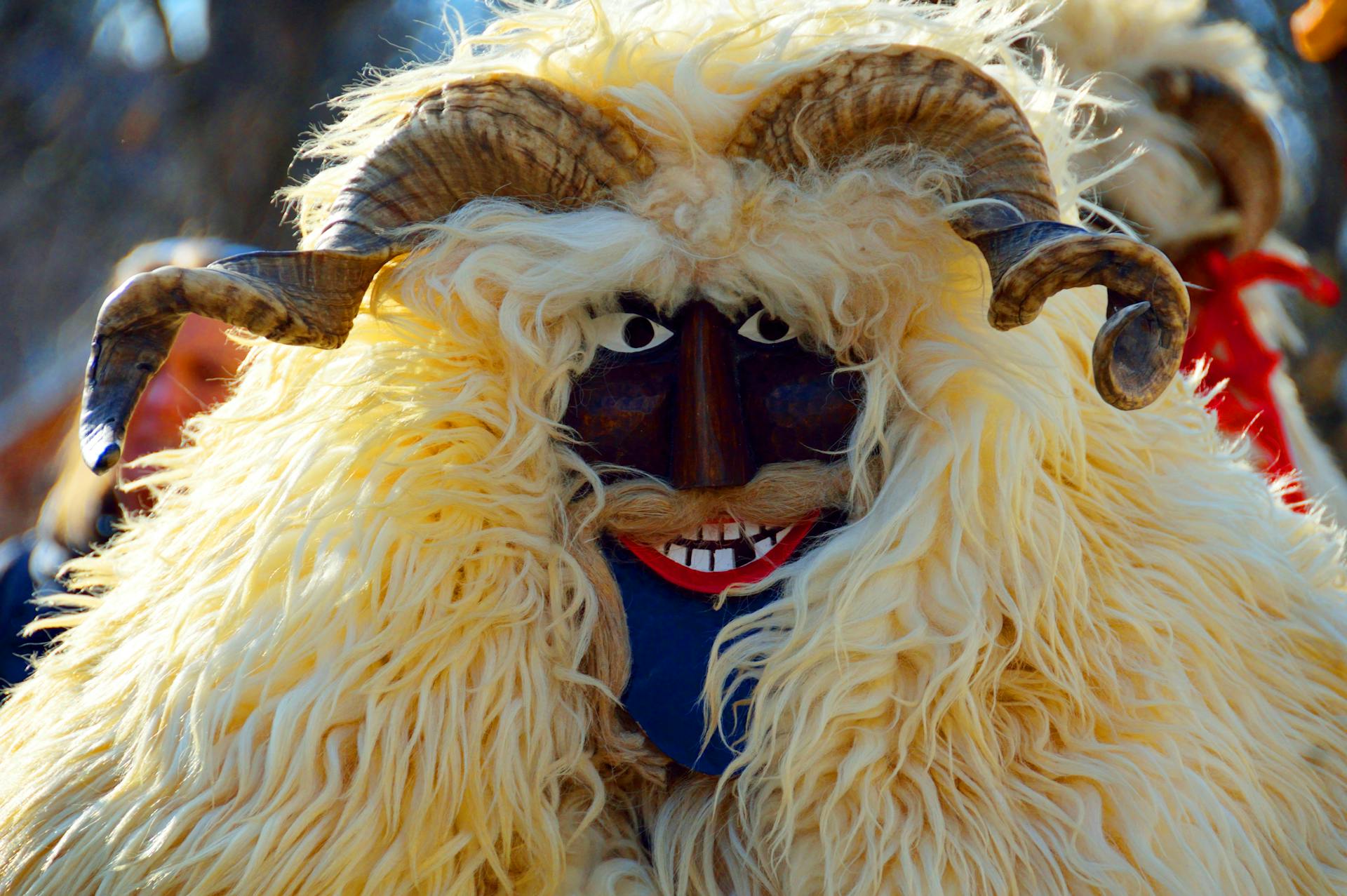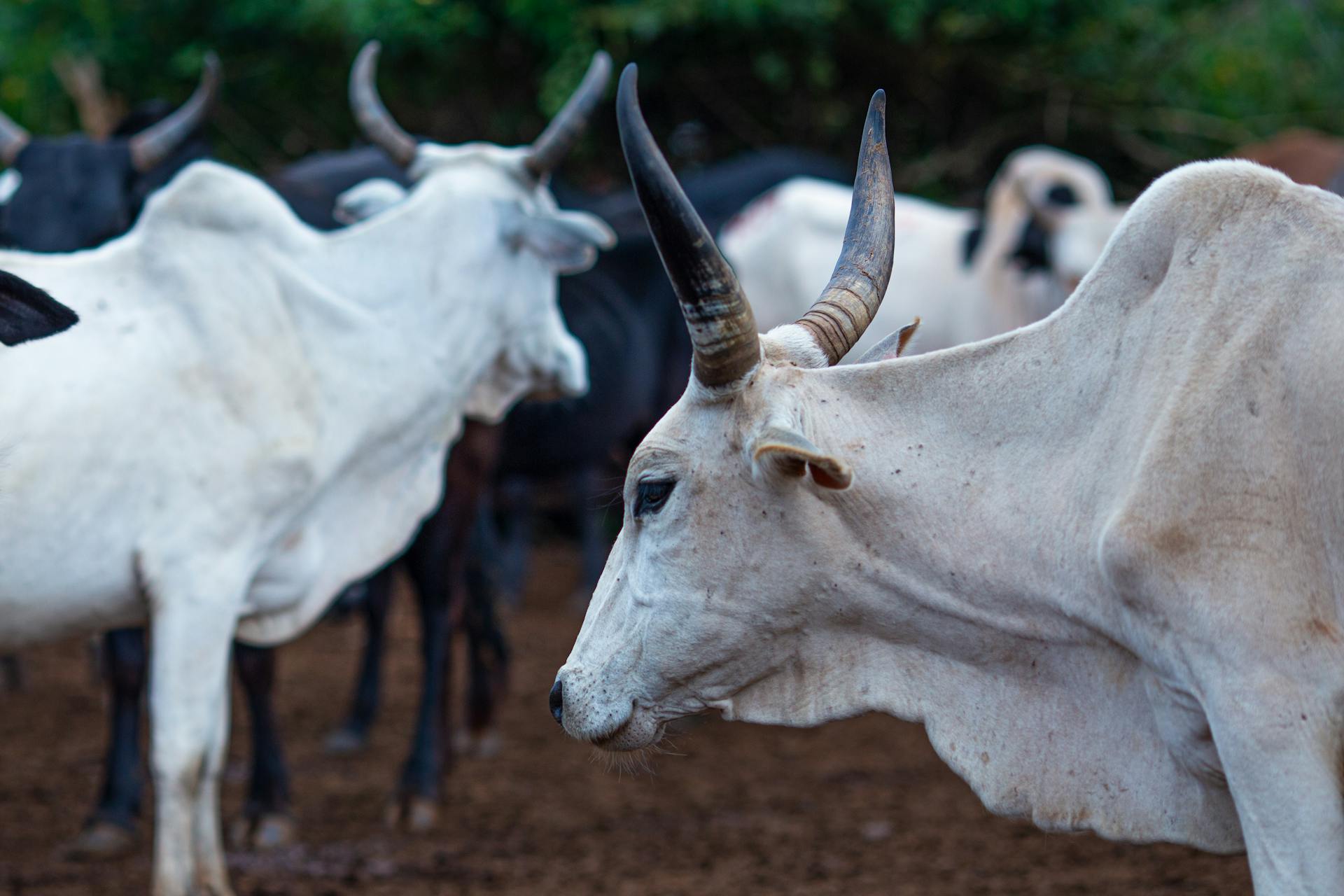
The Hungarian Herding Dog is a wonderful breed that requires regular exercise to stay happy and healthy. They need at least 1-2 hours of physical activity per day.
These dogs are highly intelligent and thrive on mental stimulation, so be prepared to engage them in activities that challenge their minds. They need early socialization and training to become well-behaved adult dogs.
Hungarian Herding Dogs are generally good with children, but as with any breed, it's essential to supervise interactions between dogs and young kids. They can be wary of strangers, so early socialization is crucial.
Regular grooming is also a must, as their thick coats shed heavily twice a year.
Quick Facts
The Hungarian Herding Dog, also known as the Mudi, is a rare breed with a rich history.
The Mudi originated in Hungary and is one of the rarest dogs in the world, with only a few thousand existing mostly in Hungary and Finland.
Here are some key facts about the Mudi breed:
- Origin: Hungary
- Size: Medium
- Breed group: Herding
- Lifespan: 12-15 years
- Coat: Medium-length, double coat in a variety of colors, including black, white, brown, and fawn
- Temperament: Intelligent, active, and loyal
The Mudi is a high-energy breed that requires regular exercise to stay happy and healthy.
All-Around Friendliness
Hungarian herding dogs are known for their strong affinity for close human bonds, which makes them fantastic companions. They thrive on interaction and attention from their family.
Mudis, in particular, are highly intelligent and eager to please, making them a joy to train and be around. They're also naturally protective of their loved ones.
These dogs can be wary of strangers, so early and consistent socialization is crucial to help them feel more at ease. This will also help them develop a well-rounded temperament.
Pumik, on the other hand, can be aloof with strangers, but once they feel comfortable, they open up and become loving companions. They're always on the lookout for new and unfamiliar things, which can be both entertaining and challenging.
Both Mudis and Pumik have a strong herding instinct, which can sometimes get them into mischief if they don't have enough physical and mental stimulation. Providing them with plenty of exercise and engaging activities can help channel their energy in a positive way.
Overall, Hungarian herding dogs make loyal and loving companions for active families who can provide them with the attention and exercise they need.
Take a look at this: Dog Names for Strong Dogs
Exercise and Training
The Hungarian herding dog, also known as the Mudi, is a high-energy breed that requires plenty of exercise to stay happy and healthy.
For this reason, regular physical activity is essential, with a minimum of daily exercise sessions that challenge their agility and stamina.
The Mudi Club of America recognizes the importance of obedience training in constructively channeling their instincts, making it a crucial aspect of their care.
To effectively train a Mudi, active owners must ensure consistent and mentally stimulating training sessions that keep their minds sharp and temperaments even.
Positive reinforcement, leveraging treats and praise, is an effective strategy in eliciting obedient behavior, and socialization is also important to help Mudis feel more comfortable with strangers.
Here are some effective training strategies for Mudis:
Regular exercise and mental stimulation will not only keep your Mudi happy and healthy but also help prevent behavioral issues and ensure a well-mannered temperament.
Health and Nutrition
Hungarian herding dogs, like the Mudi and Pumi, are generally a healthy breed, but they can be prone to certain health issues. Their lifespan is typically 12-14 years.
Regular veterinary check-ups and adherence to a vaccination schedule can help mitigate potential health problems. Weight gain must be closely monitored to reduce the risk of joint issues.
Hip dysplasia, elbow dysplasia, and luxating patella are some of the common health issues that can affect Hungarian herding dogs. Participating in the Foundation Stock Service can be instrumental for breeders in maintaining the breed's genetic health.
Here are some key health considerations for Hungarian herding dogs:
- Primary Lens Luxation (PLL) is a condition that can cause the lens of the eye to become loose and eventually displace.
- Knowing if your dog is a carrier or at-risk for these conditions can help you and your veterinarian plan for your pup's lifelong care.
Health Considerations
As a responsible dog owner, it's essential to be aware of the potential health concerns that can affect your Pumi or Mudi.
Mudis are generally a healthy breed, but they can be susceptible to certain health conditions like epilepsy, hip and elbow dysplasia, and ocular issues like cataracts. Regular veterinary assessments can help mitigate the onset of these conditions.
Proactive health management is crucial for Mudis, particularly for those with lighter coats, to prevent color dilution alopecia and subsequent dermatological complications.
To prepare for the health challenges that Mudis may face during their typical 12-14 year lifespan, regular veterinary check-ups and adherence to a vaccination schedule are essential.
Mudis can be prone to joint issues due to weight gain, so monitoring their weight closely is vital. Participating in the Foundation Stock Service can also help breeders maintain the breed's genetic health.
Some common health issues in Mudis include hip dysplasia, elbow dysplasia, and luxating patella. Knowing if your Mudi is a carrier or at-risk for these conditions can help you plan for their lifelong care.
Here's a list of potential health concerns to watch out for in your Mudi:
- Epilepsy
- Hip and elbow dysplasia
- Ocular issues like cataracts
- Color dilution alopecia
- Hip dysplasia
- Elbow dysplasia
- Luxating patella
Nutrition
Feeding your Mudi or Pumik a high-quality dog food is crucial for their overall health and well-being. Consider a diet formulated for active breeds, as they require more energy to keep up with their lively nature.
A measuring cup is a must-have when portioning out your dog's food to avoid overfeeding. Limit treats to no more than 10 percent of their daily calories to ensure they don't overindulge.

As your Mudi grows from puppyhood to adulthood and senior age, their dietary needs will change. Consult your veterinarian or professional nutritionist for advice on what to feed your Mudi at each life stage.
You should also consider your Mudi's above-average energy and exercise requirements, which means they need a diet formulated for small to mid-sized breeds with high energy needs.
Suggestion: Dog Food for High Energy Dogs
History and Origin
The Mudi breed has a fascinating history that's not easily traced, as it's believed to have come into existence naturally through the mixing of German Spitz type dogs and other Hungarian herding breeds.
The Mudi was initially not recognized as a separate breed, but in 1936, Dr. Dezso Fenyes "discovered" it in Hungary, and since then, it's been referred to as its own breed.
Many Mudis were killed during World War II, and if it weren't for breed conservationists, they might have disappeared altogether.
The Mudi breed was recognized by the Federation Cynologique Internationale in 1966 and by the United Kennel Club in 2006, with the American Kennel Club following suit in 2022.
The Pumi, another Hungarian herding dog, is believed to be a cross between the Puli and Western European herding dogs and terriers.
History

The Mudi breed has a fascinating history that's a bit tricky to pin down. They didn't come into existence through intentional breeding, but rather through the natural mixing of German Spitz type dogs and other Hungarian herding breeds.
Dr. Dezso Fenyes, a breeder and museum director, is credited with "discovering" the Mudi in Hungary in 1936, after which they were recognized as their own breed.
The Mudi breed almost went extinct during World War II, when many were killed. If it weren't for breed conservationists, they might have disappeared altogether.
The Federation Cynologique Internationale recognized the Mudi breed in 1966, and they've been gaining recognition ever since.
Pumi History
The Pumi is one of three herding dogs native to Hungary. It's a breed that's been around for a while, and its history is pretty interesting.
Pumik, the plural of Pumi, might be a cross between the Puli and Western European herding dogs and terriers. This mix of breeds has likely contributed to the Pumi's unique characteristics.
The Pumi was once considered a regional variant of the Puli, but it's now recognized as a distinct breed. This change in status reflects the breed's growing popularity and recognition.
Today, the Pumi is one of the most popular Hungarian herding dogs in Finland. Its adaptability and herding abilities have made it a favorite among Finnish dog owners.
Size and Appearance
The Hungarian Herding Dog is a small to medium-sized breed.
They typically measure between 14 and 20 inches at the shoulder.
On average, they weigh 18 to 29 pounds.
Individuals of the breed may also be smaller or larger.
Size
The Mudi is a small to medium-sized dog that typically measures between 14 and 20 inches at the shoulder. On average, they weigh 18 to 29 pounds. Individuals of the breed may also be smaller or larger.
Coat and Coloring
The Mudi and Pumi breeds have some unique characteristics when it comes to their coats and coloring.

Their coats can be quite low maintenance, with the Mudi's coat repelling dirt and debris and only needing a weekly brushing.
The Mudi's coat can be black, brown, white, fawn, grey, or a marbled mix of black and grey in color, while the Pumi's coat comes in three colors: black, white, or shades of gray.
Pumik have distinctive curls with wavy and curly hair that forms corkscrews over their entire bodies, growing up to three inches long.
Their hair stands out from the body and is made of a mixture of harsh hair and softer undercoat.
Mudi coats rarely need to be cut, if ever, and a quick freshwater rinse is often enough to get them clean after a swim.
Pumik have longer hair on the undersides of their tails and short hair around their eyes.
The Mudi sheds more heavily in the spring, but their full coat typically regrows by the end of summer.
The Pumi breed standard doesn't allow for multiple color patterns or patches, ensuring an overall appearance of a solid coat.
On a similar theme: Grey Hound Dog
Care and Maintenance
The Hungarian herding dog requires a lot of exercise to stay happy and healthy.
Regular exercise is crucial to meet their physical and mental needs, and activities that challenge them are especially beneficial.
Their curly coat is easy to care for, but it does require regular grooming to maintain its optimal condition.
You'll need to brush their coat regularly to prevent matting and tangling.
A balanced diet and routine health screenings can help prevent common health issues such as hip dysplasia.
Intelligent dogs like the Hungarian herding dog respond well to positive reinforcement training, which enables them to learn tasks quickly.
Their loyal temperament means they thrive on attention and interaction, so be prepared to spend quality time with your furry friend.
Recommended read: Flat Coat Doodle
Rescue and Adoption
If you're interested in adopting a Hungarian herding dog, there are resources available to help you find the perfect furry companion. Mudi Rescue Groups can be a great starting point.
You can contact the Mudi Club of America, which lists Mudis in need of homes on their website. They may be able to put you in touch with shelters or rescue organizations that can help you find a Mudi to adopt.
Local shelters are also worth checking, as they might have a Hungarian herding dog waiting to meet its forever family. You can try contacting your local shelters to see if they have any Mudis available for adoption.
Here are some resources to consider:
- Mudi Puppies For Rehoming and Adoption
- Mudi Club of America – Rescue
Assessing Family Compatibility
A Mudi's high-energy nature and exercise requirements must be evaluated against your family's lifestyle. This is crucial to ensure a happy and healthy relationship.
Their intelligence and protective nature make them excellent companions, but their compatibility with children and other pets depends on thorough socialization from a young age.
Dedicated training and early socialization are key to unlocking a Mudi's full potential as a loyal and protective companion for adults and children.
Here are the key aspects to consider when assessing a Mudi's compatibility with your family:
- Temperament & Training
- Exercise & Environment
A well-trained and socialized Mudi can thrive in an environment where they can bond with children and adults, making them a great fit for families who are willing to put in the effort.
Everything You Need
The Hungarian herding dog, a breed that's as intelligent as it is energetic. Originating from Hungary, this medium-sized herder is recognized for its intelligence and loyalty.
To ensure this breed fits your lifestyle, it's essential to understand its origins and characteristics. The Mudi, a specific type of Hungarian herding dog, requires plenty of exercise to stay happy and healthy.
You'll want to provide your Mudi with regular physical activity, as neglecting this can lead to behavioral issues. This breed also makes an excellent watchdog, so you can rest assured it'll keep a watchful eye on your family.
Obedience training is crucial for constructively channeling the Mudi's instincts. With consistent training and socialization, your Mudi will thrive and become a beloved member of your family.
Here are some key characteristics to keep in mind:
- Requires plenty of exercise
- Makes an excellent watchdog
Regular grooming and health screenings are also essential to mitigate common hereditary conditions. By prioritizing your Mudi's care, you'll be rewarded with a loyal companion that's full of energy and life.
Breed Information
The Mudi and Pumi are two Hungarian herding dogs that are highly intelligent and require a lot of exercise and mental stimulation.
Their curly coats are distinctive and relatively easy to care for, but they do need regular grooming to stay in optimal condition.
As herding breeds, they thrive on activities that challenge their physical and mental faculties, and neglecting exercise and mental stimulation can lead to behavioral issues.
Their exercise and mental stimulation requirements are substantial, and they respond well to positive reinforcement training, which enables them to learn tasks quickly.
Rare Breed
The Mudi is a rare breed that's known for its exceptional intelligence and lively personality. They require a lot of exercise and mental stimulation to prevent behavioral issues.
Their exercise needs are substantial, and if neglected, can lead to problems. They need regular physical activity to stay happy and healthy.
Mudis also need routine grooming to stay clean and well-maintained. This includes regular health screenings to catch any potential health issues early on.
Comprehensive Guide
The Mudi is a Hungarian herding dog that's known for its high intelligence and robust energy levels.
To keep your Mudi happy and healthy, you'll need to provide regular exercise and mental stimulation – neglecting these needs can lead to behavioral issues.
This breed thrives on activities that challenge its physical and mental faculties, so be prepared to engage your Mudi in activities that keep it active and engaged.
Their curly coat is distinctive and relatively easy to care for, but it does require regular grooming to maintain its optimal condition.
As an intelligent breed, the Mudi responds well to positive reinforcement training, which enables it to learn tasks quickly.
However, vigilance is essential in monitoring for health conditions such as hip dysplasia, which can be a common issue in this breed.
Regular health screenings can help mitigate common hereditary conditions, so be sure to schedule regular check-ups with your veterinarian.
A fresh viewpoint: Why Does My Male Dog Keep Licking My Female Dog
Sources
- https://www.thesprucepets.com/hungarian-dog-breeds-4787994
- https://dogtime.com/dog-breeds/mudi
- https://caninechronicle.com/dog-show-history/remembering-our-past%E2%80%8E/mudi-an-old-and-rare-herding-breed-from-hungary/
- https://dogwondersworld.com/breeds/mudi/
- https://www.wisdompanel.com/en-us/dog-breeds/pumi
Featured Images: pexels.com


